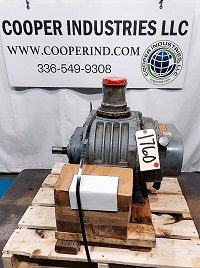Oil changing and dust removal – the essentials of vacuum pump care
While there are dry running vacuum pumps that do not require any oil, composites industry vacuum pumps are typically of the oil flooded rotary vane type. The reason the composites industry uses oil flooded pumps is because affordable oil-free vacuum pumps are usually limited to a maximum of about 85% vacuum. This is not enough for good quality resin infusion and pre-preg work, which usually requires pump vacuum levels of 95% and better – a level of vacuum easily achieved by an oil flooded rotary vane pump.
OK, so composites industry vacuum pumps have oil in them. Why is that a big deal?
- Vacuum pumps are always sucking contamination towards them. This contamination can be in the form of vapours such as organic resin solvents and water vapour extracted from the water absorbed into fabrics during manufacture and storage. (See Vacman’s Note “Vapour – the unseen enemy in composites”.) Another form of contamination can be fine dust removed from the dry fabrics and pre-pregs, or particles of broken resin arising from the handling of vacuum lines containing cured resin. Solvent vapours passing through the pump tend to degrade the lubricating oil circulating around the pump. Water vapour entering into a vacuum pump, especially one that is cold, will condense into liquid water and this will coalesce with the pump oil. Water circulating with the pump oil will reduce the vacuum capability of the pump because water will boil readily on under vacuum on the inlet side of the pump. Pumps which are left idle with water contaminated oil will also corrode and wear more quickly when next restarted. As a further factor to be considered, there is a very fine filter inside the typical composites industry vacuum pump. This filter is called the exhaust oil mist filter or oil mist separator and it has to be fine enough to stop oil smoke being discharged from the pump. Contaminated oil will block the oil mist filter and raise the working pressure inside the pump, ultimately overloading the motor (and possibly rupturing the oil mist filter if it is very badly contaminated).
- Vacuum pumps for composites industry use are cooled by the air flow from the motor fan. They will typically run with a pump oil temperature in the 90 0C to 110 0C (194 0F to 230 0F) range. The pumps are designed to run at this temperature to minimise the affect of water vapour condensing in the pump oil. (See point 1.) While this temperature range will improve water vapour removal, higher temperatures will shorten oil and motor bearing life. With clean external surfaces and in a moderate ambient temperature range of, say, 15 0C to 40 0C (59 0F to 104 0F), the oil temperature will sit within the desired range due to heat dissipation from the pump and motor surfaces. However, if heat radiation from the pump and motor is reduced because of dust build-up on the pump and motor fins the pump and motor temperature will rise and both pump and motor life will be shortened.
Moral of the story – change the oil often and keep the pump clean externally
For optimum pump life, the 2 biggest favours you can do for your vacuum pump are to change the pump oil whenever it is contaminated and to keep the pump and motor surfaces clean. Since vacuum pump oils are generally moderate cost and readily available compressor oils, oil changing should not be expensive, nor should it take much time. As long as compressed air is available, cleaning the pump and motor will take very little time.
Oil change interval
While changing the oil at 500 hours is the normal recommendation, this interval should be the maximum time interval, not a hard and fast rule. This is because oil contamination is highly variable, depending on individual process conditions. In some cases, such as when a vacuum pump is used to bag down wood based fibre boards for mould making, it can be advisable to change the oil after each use because of the extremely high water vapour loading. The most practical way to assess oil condition is to inspect the oil visible in the oil sight glass after the pump has been stopped for a few minutes. If it is clear and “oily” in appearance (usually a pale gold colour) it will be fine. If an opaque dirty black or brown, it will be loaded with dust or carbonised oil. If the colour is opaque milky white/murky pale brown, it will be contaminated with water vapour. If the latter and if the oil has been changed recently, you may be able to clean up the oil by leaving the pump run at full vacuum overnight. If back to a clear gold colour in the morning, the oil will be fine. If still murky, change it.
Note that using synthetic oil to extend the oil change interval is not recommended. While synthetic oils can be beneficial in compressors and gearboxes, these applications do not suck in contamination to anywhere near the extent a composites industry vacuum pump does. In our view, with vacuum pumps it is better to use a moderate cost all and change it frequently to avoid the build-up of contaminants.
Oil drain procedure
- Make sure the pump is at operating temperature before changing the oil, ideally after running for at least 30 minutes, although 60 minutes is better. The reason for getting the pump hot is to lower the oil viscosity as much as possible for maximum drainage.
- Switch off the pump and undo the oil drain plug. If tight to undo, do not apply a long lever arm to the wrench. Instead, give the wrench a sharp tap with a soft headed hammer. The reason for a avoiding a long lever arm is because excessive torque may lift one end of the pump and break the rubber vibration isolators under the pump. Bear in mind that the oil being drained will be hot – keep fingers clear of the hot oil!
- If the pump is on a mobile machine, such as a Vacmobile, lock the castors on the oil drain side of the machine and lift the other side of the machine for better oil drainage.
- While tilting the pump will improve drainage, some oil will remain in the pumping chamber. If the oil is badly contaminated, the oil in the pumping chamber should also be removed. To remove this remaining oil, replace the oil drain plug and tighten it hand tight. Also make sure the oil fill plug is in place and hand tight. Briefly start and stop the pump – a second of running time will be long enough. Once the pump has stopped, remove the drain plug again and drain the remainder of the oil. Do NOT run the pump with either the oil drain plug or the filler cap removed – as that is likely to make a big mess!
- After draining the oil, refit and tighten the oil drain plug.
Oil filling procedure
- Check that the oil drain plug is in place and tight.
- Select the correct grade of oil for the particular pump model being serviced.
- Add oil slowly, with the pump in a level position. For pumps fitted with a single round oil sight glass, the ideal level is between ½ way up the sight glass and the ¾ level. With pumps with 2 sight glasses one above the other, a level about ½ way up the top one will be fine. In either case, do not overfill.
- Refit the oil filler plug and tighten.
- Switch on the pump and check that the oil level remains below the top of the sight glass.
The reason it is important not to over fill the pump is because there is a possibility of liquid oil being blown up into the oil mist filter under high air flow conditions, e.g., when beginning to pump down. If liquid oil is blown up into the oil mist filter, there is a risk that the filter will become saturated with liquid oil which the fine filter is not designed to handle. If over-saturated with oil, the pressure inside the pump will increase excessively and there is a risk the element will rupture and need to be replaced.
Avoiding over-filling with oil is critical. Always make sure that there is an air bubble of about ¼ of the oil sight glass diameter visible above the oil.
Cleaning dust from the external surfaces of the motor and pump
It will usually be most convenient if dust is removed from the motor and pump while the pump is running prior to an oil change. Using a compressed air gun, blow dust from all accessible surfaces, but do not blow debris into the exhaust port of the pump. One of the important areas to focus on is the fan end of the motor, as this is where dust and fibres tend to accumulate. Dust will also tend to adhere to the blades of the motor fan, significantly reducing its efficiency. Without poking the air nozzle into the moving fan blades, give the motor fan end a very thorough blow down.
Exhaust oil mist filter replacement
Replace the exhaust oil mist separator and clean or replace the gas ballast filter as soon as one of the following occurs:
- New oil discolours quickly after changing.
- Oil smoke is discharged from the exhaust port. But don’t confuse oil smoke with water vapour being extracted from a wet material. If any possibility of a high water vapour load, recheck for smoke after the pump has run at full vacuum overnight with the inlet valve closed.
- Motor overload trips on starting or during the course of a job – but first check power supply voltage is correct and the power cord is in good condition.
- After 1 year of daily use, or after 2 years of moderate use
- After testing with a back-pressure gauge in accordance with the pump maker’s instructions. This is the surest method of testing, but it does require a pressure gauge and an understanding of the procedure.
Exhaust oil mist filter replacement is usually simple and will typically involve exposing the filter element as shown in the photo.






